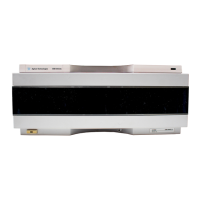12 Agilent 1260 Infinity DAD and MWD User Manual
1
Introduction
Optical System
Lamps The light source for the UV-wavelength range is a deuterium lamp with a
shine-through aperture. As a result of plasma discharge in low-pressure
deuterium gas, the lamp emits light over the 190 nm to approximately 800 nm
wavelength range. The light source for the visible and SWNIR wavelength
range is a low noise tungsten lamp. This lamp emits light over the wavelength
range 470 – 950 nm.
Achromat
(Source Lens)
The achromat receives the light from both lamps and focuses it so that the
beam passes through the flow cell.
Holmium Oxide
Filter
The holmium oxide filter is electromechanically actuated. During the holmium
filter test it moves into the light path.
Cell Support
Window
The cell support window assembly separates the holmium filter area from the
flow cell area.
Flow Cell
Compartment
The optical unit has a flow cell compartment for easy access to flow cells. A
variety of optional flow cells can be inserted using the same quick, simple
mounting system. The flow cell can be removed to check the optical and
electronic performance of the detector without having influences from the
flow cell.
Spectrograph The spectrograph material is ceramic to reduce thermal effects to a minimum.
The spectrograph consists of the spectrograph lens, the variable entrance slit,
the grating and the photodiode array with front-end electronics. The
spectrograph lens refocuses the light beam after it has passed through the flow
cell. The sampling interval of the diode array is < 1 nm over the wavelength
range 190 – 950 nm. Depending on the wavelength this varies from 1.0 to 1.25
diodes per nanometer (for example a diode every 0.8 to 1 nm).
For a small wavelength range, the small non-linearity could be neglected. With
the wavelength range from 190 – 950 nm a new approach is required to
achieve wavelength accuracy over the full range. Each spectrograph is
calibrated individually. The calibration data is stored in the spectrograph on
an EEPROM. Based on these data, the built-in processors calculate absorbance
data with linear intervals (1.0, 2.0, …) between data points. This results in an
excellent wavelength accuracy and instrument-to-instrument reproducibility.
Variable Entrance
Slit System
The micro-slit system makes use of the mechanical properties of silicon
combined with the precise structuring capabilities of bulk micro-machining. It
combines the required optical functions — slit and shutter — in a simple and
compact component. The slit width is directly controlled by the
micro-processor of the instrument and can be set as method parameter.

